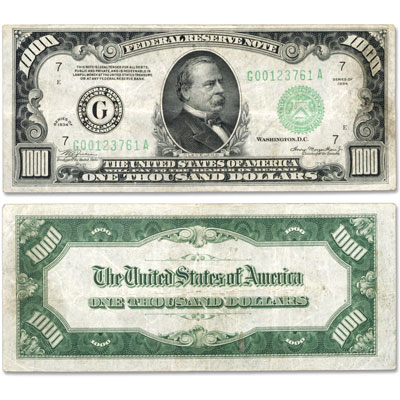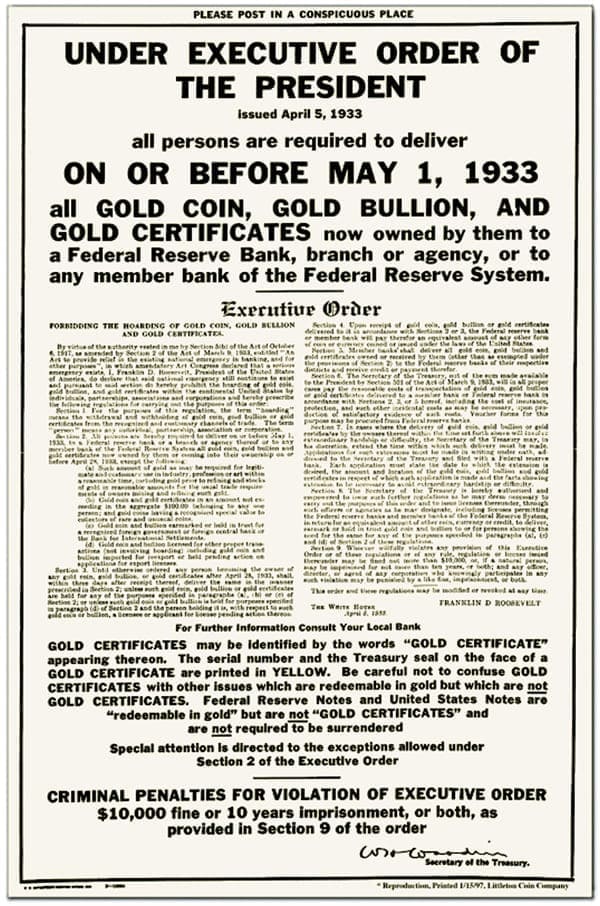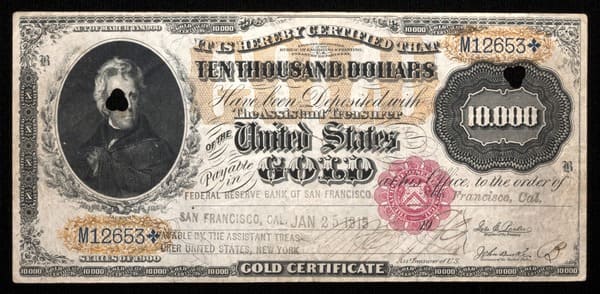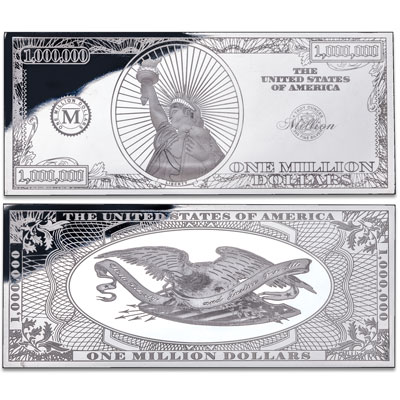The Story Behind…
High Denomination U.S. Notes

There’s just a special feeling to pulling a $50 or $100 bill out of your wallet. Now, imagine doing that with a $500… or even $10,000 note!
Once, there was a time when that was possible. The history of high-denomination (higher than $100) U.S. Notes stretches back to 1861, with Interest bearing notes, Silver Certificates, Treasury Notes and more. Today, though, we’re going to look to 1918 – when the first high-denomination Federal Reserve Notes were released.
These Federal Reserve Notes were issued in denominations of:
- $500 – large size $500 Federal Reserve Notes displayed blue seals and a portrait of John Marshall on the face, with a vignette titled De Soto Discovering the Mississippi on the back. In 1928, small size notes with a green seal debuted, depicting William McKinley on the face and the denomination on the back.
- $1,000 – two versions of the $1,000 Federal Reserve Notes were issued as well. The large-size notes, from Series 1918, showed a blue seal and portrait of Alexander Hamilton on the face. The back showed a bold American eagle with flag. Beginning with Series 1928, the notes were reduced to the more modern small size, featuring a green seal and portrait of Grover Cleveland on the face. The denomination was displayed on the back.
- $5,000 – the large size notes showed fourth president James Madison on the face, with a vignette titled Washington resigning his Commission on the back. Their smaller counterparts depicted James Madison on the face and the denomination on the back
- $10,000 – printed for Series 1918, large size $10,000 Federal Reserve Notes depicted Secretary of the Treasury Salmon P. Chase on the face. The back displayed a vignette titled Embarkation of the Pilgrims. The small size $10,000 notes also showed Chase’s portrait, while the back displayed the denomination.
 Replica of President Roosevelt’s 1933 Gold Recall Order
Replica of President Roosevelt’s 1933 Gold Recall OrderThe biggest of the big
The notes with the highest denomination ever issued on U.S. notes were printed for three short weeks, from December 1934 to January 1935. These $100,000 Gold Certificates featured a portrait of 28th president Woodrow Wilson on the face, with the denomination on the back.
You may have noticed that these notes were printed after Franklin D. Roosevelt had issued the Gold Recall Order of 1933. These notes were never legal to own by private citizens – instead, they were created only for transactions between the Treasury and the Federal Reserve System.
Money that was never intended for the public!

High-denomination notes like these were created primarily for use in settling inter-bank transactions, so the public rarely saw them. Keep in mind, these were the days before electronic payments and wire transfers! Some examples did make it into private ownership, meaning that some examples still exist for collectors lucky enough to come across one.
As the end of WWII neared, the government noticed a lack of demand for these U.S. notes. So, in July of 1945, all production of high-denomination notes was stopped. But it wasn’t until 1969 – nearly a quarter of a century later – that the Department of the Treasury and the Federal Reserve System announced their decision to retire the denominations permanently.

Since then, any time a high-denomination U.S. note is paid in to a bank, it’s sent to a Federal Reserve Bank and destroyed. Thankfully, some private owners held on to their pieces – preserving them for today’s collectors!
For all the high-denomination U.S. notes out there, we’ve (unfortunately) never had anything as high a $1 million bill. But for those of us who dream of being a high roller, there are some nicely detailed fantasy pieces out there! Do you dream of owning one of these high-denomination notes? If so – which one?



